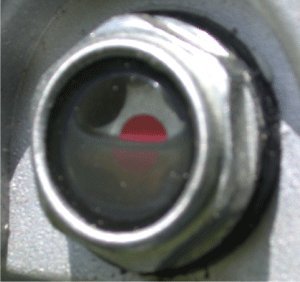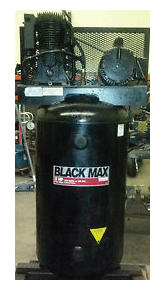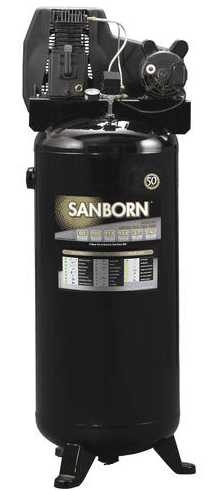It can be quite a daunting task trying to figure out how to measure, change, or purchase replacement Sanborn compressor oil, how much to use and what is the correct Sanborn oil to use right? Well, fear no more, I will answer all these questions about checking, changing, and purchasing replacement Sanborn compressor oil for you.
Table of Contents
- What kind of Oil goes in a Sanborn Compressor?
- How Much Sanborn Oil to Use in a Sanborn Compressor?
- Methods for Checking Sanborn Compressor Oil
- How to Change Sanborn Compressor Oil
- FAQs (Frequently Asked Questions)
What kind of Oil goes in a Sanborn Compressor?
It is extremely important to refer to your compressor manual before purchasing Sanborn oil for your Sanborn compressor. We have numerous Sanborn compressor manuals available on our brand page so please visit here first!
The manual will tell you what Sanborn oil is compatible with your air compressor, if you cannot locate your manual, please contact Sanborn directly or visit their website to download a manual for your compressor.
Sanborn Compressor Oils Available on Amazon
Sanborn Manufacturing was acquired by Coleman Powermate, Inc. and so there are a couple of Powermate compressor oils readily available on Amazon that will suit your Sanborn compressor. The first is a synthetic blend of non-detergent oil, for which a user has left a review saying that they’ve used it in their Sanborn compressor and it works!
- 1 quart bottle with convenient oil level indicator
Prices pulled from the Amazon Product Advertising API on:
Product prices and availability are accurate as of the date/time indicated and are subject to change. Any price and availability information displayed on [relevant Amazon Site(s), as applicable] at the time of purchase will apply to the purchase of this product.
The second is an Amazon choice for Sanborn compressor oil and is an all-weather non-detergent blend that boasts fantastic reviews!
Prices pulled from the Amazon Product Advertising API on:
Product prices and availability are accurate as of the date/time indicated and are subject to change. Any price and availability information displayed on [relevant Amazon Site(s), as applicable] at the time of purchase will apply to the purchase of this product.
Alternative Compressor Oils Available on Amazon
A few alternatives to the Sanborn-advised compressor oils are produced by Mobil. Again, it is very important to ensure the oil is compatible with your air compressor before putting it into the system, so please check first!
The first is the Mobil 101016 Rarus which is suitable for reciprocating air compressors whether they’re single or multistage. This oil lubricant boasts excellent water separability, protection against rust and corrosion, long life for extended oil drain, and provides your compressor with very clean air valves.
Prices pulled from the Amazon Product Advertising API on:
Product prices and availability are accurate as of the date/time indicated and are subject to change. Any price and availability information displayed on [relevant Amazon Site(s), as applicable] at the time of purchase will apply to the purchase of this product.
The second is the Mobil 100870, boasting similar benefits as the previous oil but the potential to work with reciprocating, rotary screws, and rotary vane compressors.
Prices pulled from the Amazon Product Advertising API on:
Product prices and availability are accurate as of the date/time indicated and are subject to change. Any price and availability information displayed on [relevant Amazon Site(s), as applicable] at the time of purchase will apply to the purchase of this product.
How Much Sanborn Oil to Use in a Sanborn Compressor?
It is a difficult task determining how much Sanborn oil your specific model of compressor pump requires without having the actual manual at hand.
If you’re struggling to locate your specific manual, please contact Sanborn directly or search the internet for the specifications of your Sanborn compressor and its model to locate it!
Methods for Checking Sanborn Compressor Oil
I will provide you with some basic tips on how to check the Sanborn oil amount inside your compressor and then present to you a guide on how you can go about changing it.
Check Oil With The Sanborn Oil Sight Glass
You can check the amount of Sanborn oil inside the compressor pump using a sight glass which is shown in the image below. You should ideally aim for the oil being about half way up the red dot.

Check Oil With The Sanborn Oil Dipstick
It’s possible that the pump does not have a sight glass, in this case, you can check the Sanborn oil using the dipstick. These will typically be found as part of the Sanborn oil fill tube cap and they extend down into the sump and Sanborn oil.
You should take the dipstick out of the sump and give it a wipe clean then dip it back into the sump, when you pull it out again you can check Sanborn oil level by using the markings on it.
Note: Your Sanborn Air Compressor Operation Manual should indicate whether you should screw the oil dipstick back into the hole completely, or just hold the dipstick back to the hole WITHOUT threading back into the hole.
Example Ambiguous Instructions for checking oil level with a dipstick
“Remove the dipstick and ensure that the oil level is between the high and low marks. Replace the dipstick.”
In this instance, the way these instructions are interpreted by most is the “literal” sense:
- Remove the dipstick from it’s “fully threaded in position”
- Check the oil level immediately after removing the dipstick from the fully threaded position
- Add or remove oil based on the reading
- Return the dipstick to it’s fully threaded position if no oil is required
The thing that’s missing from these instructions is the “common wisdom” (as detailed on this thread over at Bob The Oil Guy’s Forum) is that we should remove the dipstick – then WIPE IT CLEAN, before proceeding with taking a reading of the oil level. This then introduces confusion and ambiguity around which approach to take:
- Check the oil with the dipstick threaded all the way back in
- Check the oil with the dipstick “butted up against” the threaded hole
It would stand to reason that a compressor manufacturer would take the same approach to “how you should measure the oil level in your air compressor” in one of the 2 ways above (if using a threaded dipstick).
For Sanborn, as demonstrated in this example of an operation manual for a 400B, 500B and 500BP – the manual explicitly states the following:
“When checking the oil, the dipstick must be screwed in finger tight, or pushed in, or remove the oil fill plug and visually check the oil comes up to the bottom of the threads”
In this short sentence, they’ve pretty much clarified the potential ambiguity across the range of oil fill level checking mechanisms – Threaded Dipstick, O-Ringed Dipstick or simple threaded plug.
If in doubt, consult your operation manual.
If the operation manual is ambiguous, hopefully, the above provides some guidance on how to interpret the information provided.

Alternative Method for Checking Sanborn Oil
If you don’t have a sight glass or dip-stick on your Sanborn compressor, an alternative method you could certainly use is draining the Sanborn oil from the tank into a reservoir.
How to Drain Sanborn Oil from the Sump
First of all, locate your Sanborn oil drain which is a plug underneath the pump housing. You can then drain the Sanborn oil into a reservoir to allow you to gauge how much Sanborn oil was in your pump.
Note: Please be careful when draining the Sanborn oil in case you get any spillages. A useful tip is laying something out on the floor below the compressor to catch any potential spillages.
How to Change Sanborn Compressor Oil
Changing the Sanborn oil on each model of Sanborn compressors can be slightly different. This may sound silly but before doing anything, ask yourself if your compressor definitely is oil lubricated. If you must, check the model manual or contact Sanborn directly to find out.
Changing Sanborn Compressor Oil Process
After following the previous steps described for draining the Sanborn oil from the compressor into a reservoir, securely tighten the plug back into the bottom of the sump.
There will be a port at the top of the Sanborn oil sump into which you can add the replacement Sanborn oil you have. It is difficult to be any more specific as the process can vary depending on the specific model of your Sanborn compressor.
The aim is to add roughly the same amount of Sanborn oil that you’ve removed or gauge it using the sight glass or dipstick if you have them. Be cautious though, as you do not want to overfill the sump.
Note: when filling the Sanborn compressor with Sanborn oil, please ensure you do not fill the air intake on the pump.
Summary
The above methodology is simplified for ease into the following steps:
- Check Sanborn compressor oil level
- Locate the plug beneath the compressor sump
- Drain the Sanborn oil into a reservoir
- Securely tighten plug back into sump
- Locate the Sanborn compressor oil port
- Replenish the compressor with the same amount of Sanborn oil as removed (ensuring you do not overfill)
There is no way to be anything but vague when providing advice about changing Sanborn compressor oil without having access to every air compressor model manual, and assuming that the manual tells the reader what the Sanborn oil volume is.
FAQs (Frequently Asked Questions)
Sanborn back max oil capacity, type, and grade
by John L
(NC high country)
recently inherited Sanborn Black Max, 5hp, two stage, 80 gal compressor. Can only read first three and last two of model number –
B51???24, no manuals. Unit is all black in color with large chrome label stating “Sanborn manufacturing Co” and ph# for product asst (not working). Been sitting for about 4 years inside garage. Ready to wire 220v and try to operate but want to change compressor oil. Don’t know how much and what kind to replace it with. Would love to have manuals, but at least help with info about oil capacity and type/grade. Thanks much for any help.

Oil capacity
by: John L
Thanks much to all for the helpful hints.
Still cant see thru the glass, but can pick out the small bubble in the middle (no color). I’m going to add enough to equal 2qts and fabricate a dip stick to insert thru filler hole to measure to level of bubble, cap it off and keep my fingers crossed.
Feb 02, 2015
Oil viscosity
by: Pete
I recently acquired my fathers Black Max air compressor. It is a 3hp model in like new condition and fortunately the owners manual was in his filing cabinet. The manual doesn’t say the fill volume but it does say to use either SAE 30 or SAE 40 depending on the ambient temperature. I’m going to change the oil with Amsoil air compressor SAE 30/40 and see what happens. I don’t think there is 10 hours time on this compressor but the manual did say to change the oil after the initial 8 hours.
Oil level
by: Jack
The Oil level is to the red dot on the sight glass approx half way up. My Black Max takes around 2 qts when I change it. I use the compressor oil sold at the local auto supply store.
Dec 03, 2014
Sight glass level
by: Bill
Most of the sight glasses we’ve seen for air compressors have a small dot in the center, and the oil typically is added until the oil level is in the center of the dot.
Update on progress
by: Anonymous
Unit is now wired. Decided to go with “compressor oil” from lowes. It is 20w and comes in half qts. Cleaned sight glass best I can but still barely usable. Added quart and half and ran unit for 10 sec, so far so good. Can not see level in glass.
Will fabricate makeshift dip stick and fill to appx half the depth of glass and run again. Anyone have idea how far up the sight glass it should be?
Compressor oil
by: Mark
I have a black max 5hp 60 gallon that is about 15 years old and the compressor uses 30 wt. non detergent oil.
Compressor oil
by: John L
Thanks Doug.
There is no dip stick I can find, but does have a sight glass that appears dingy/dirty. Filler cap is on front right corner, same side as glass. I will try judging amount by the drained amount and hope it is full when I start. Thanks much for your response.
Oil
by: Doug in s.d.ca
I believe this is a piston compressor, so you can use either “compressor oil” or maybe 20W non-detergent synthetic.
Don’t know if that has a sight glass or a dipstick, but drain it first to get an idea of the capacity
Sanborn 5hp 60 gal Magna force oil level check
by Karl
(Belleville Michigan)
My Sanborn 5hp 60 gal magma force owners manual has poor description on oil level check. It says screw in oil level plug finger tight and check level or fill oil to bottom of fill hole threads resulting in two very different oil levels.
What is the oil capacity or proper procedure.
Also it says use 30 weight below 32f it 40 weight above 32f , what oil can I uses year round?
Sometimes I use the compressor to fill tires in the winter.

Magna force oil level check
by: Doug in s.d.ca.
Sounds like you have a general info type manual. If you have a dipstick, go by that. If it’s just a plug then you go by the bottom threads.
As to the oil, is this inside or outside? If it actually gets below freezing, probably the easiest thing is to build some sort of vented, insulated enclosure for it. Add a block heater if it gets hard to start in winter with the 40 weight.
Oil level check
by: Karl
Thanks for the info. I’m referencing a Sanborn manual found on this website.
Perhaps you are correct as I read again it does reference different configurations of oil level checks.
One thing that does not seem right is that big compressor is only taking three fourths of a quart to register full on the screw in plug/ dipstick, however, oil is only about half way up on the large oil reservoir on the compressor bottom which seems unusual. Hmmmm.
The compressor is in a unheated garage and sees occasional use, so if multi-viscosity oil can not be used, I suppose I’ll choose 30w year round and should be OK with occasional use.
Magna force oil level check
by: Doug in s.d.ca.
If your cut-out is over about 130PSI then you have a two stage pump. Either way, it takes 18 Oz. of oil.
Looking at the base on the left side opposite the flywheel, is where the dipstick should be. If you’re looking at the threads on the plug in the center of the base, that’s the drain, and not where you check oil level.
But that could be wrong, if you have a different pump than what it seems you have. Is there a plate with an actual model number? We could be sure with that.
Also, if you use the machine such that it only cycles once to maybe thrice per use, then the 30 weight should be OK.
If you have any questions about Sanborn compressor oil, changing it, which to use and how to use it then please leave a comment below with photos if applicable to help others respond to you!
